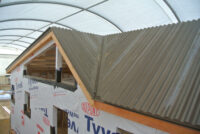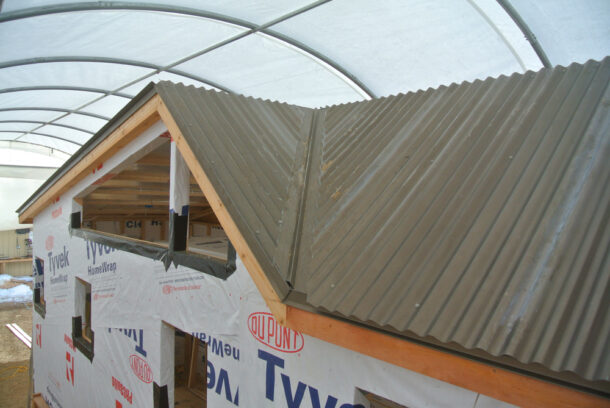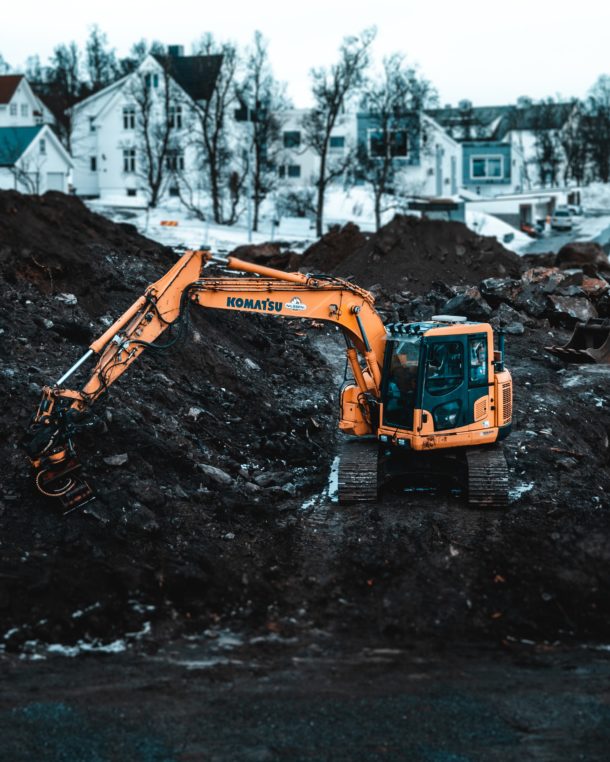Living in a tiny house doesn’t mean sacrificing outdoor space. With the addition of a roof deck, you can elevate your living and expand your overall square footage. This comprehensive guide will walk you through the process of constructing a tiny house roof deck to help maximize space in your tiny home. We’ve got you Read more
Whats New

Living in a tiny house doesn’t mean sacrificing outdoor space. With the addition of a roof deck, you can elevate your living and expand your overall square footage.
This comprehensive guide will walk you through the process of constructing a tiny house roof deck to help maximize space in your tiny home.
We’ve got you covered on everything you need to know to complete this project. A well-built roof deck can not only provide additional living space. It also adds value and style to your tiny home.
Read on!

Structural Assessment
Before beginning your roof deck construction, it’s essential to assess the structural integrity of your tiny house. You want to ensure that the structure can support the added weight and stress of a roof deck.
Consult with a professional contractor or engineer to determine if any reinforcements are needed for your home’s existing frame. It may also be necessary to obtain permits from your local building department before starting construction.
Design and Permits
Once you’ve determined that your tiny house can support a roof deck, it’s time to start planning the design. Think about how you want to use the space and what features you want to include.
Consider using lightweight materials such as composite decking or aluminum for the structural components of your roof deck. These materials are not only durable but also help keep the overall weight of your tiny home down.
Don’t forget to check with your local building department for any necessary building permits before proceeding with construction. This step is crucial to ensure that your project complies with building codes and regulations.
Safety and Access
Safety should be a top priority when constructing a roof deck on your tiny house. Be sure to follow all safety measures and use proper equipment throughout the construction process.
You’ll also want to consider how you will access your roof deck. Options include a ladder or stairs, depending on the height of your tiny home and personal preference. To help you make sure of safety, you might need to get help from professionals like WeLike Construction roofing companies.
Materials and Construction
When it comes to materials, consider using lightweight and weather-resistant options. This will help keep the weight down and ensure your roof deck can withstand various weather conditions.
Start by constructing the frame of your roof deck, making sure to follow all safety measures and building codes. Then, install the decking material and any additional features, such as railings or seating areas.
Utilities and Amenities
Don’t forget about utilities and amenities when planning your roof deck. Think about how you will access electricity, water, and other necessities while on the deck.
It’s also a great idea to incorporate some amenities into your design, such as outdoor lighting or built-in seating areas. This will not only add functionality but also enhance the overall aesthetic of your tiny house roof deck.
Follow This Guide To Building a Tiny House Roof Deck
With proper planning and execution, constructing a roof deck for your tiny house can provide numerous benefits. By following this comprehensive guide on constructing a tiny house roof deck, you can elevate your living and make the most out of limited space in your tiny home. Start planning and create your dream rooftop oasis today!
Should you wish to explore more topics aside from this tiny house roof deck guide, visit our website.

The construction industry is growing at a rapid pace. And with it comes the demand for construction equipment. This increase in demand has put pressure on construction equipment manufacturers to manage their supply chain efficiently. They must meet customer needs while also maintaining profitability. However, this task is not without its challenges. In this article Read more
The construction industry is growing at a rapid pace. And with it comes the demand for construction equipment.
This increase in demand has put pressure on construction equipment manufacturers to manage their supply chain efficiently. They must meet customer needs while also maintaining profitability. However, this task is not without its challenges.
In this article, we will discuss the challenges that construction equipment manufacturers face in their supply chain. We’ll also gain insights into how they can navigate through them.
Let’s get started!

The Impact of Globalization on the Supply Chain
One of the biggest challenges faced by construction equipment manufacturers is the impact of globalization on their supply chain. With increased competition and customer demand, manufacturers are under immense pressure. They have to reduce costs while maintaining quality.
To stay competitive in the global market, manufacturers must source materials and parts from around the world. This can lead to longer lead times. It also means higher transportation costs.
This adds complexity to the supply chain. It also makes it harder to manage and control.
Addressing Quality Control Issues
Construction equipment manufacturers also face issues in their supply chain. There’s a risk that they’ll receive substandard or faulty parts. This is because they get materials from different suppliers.
This can lead to delays in production. This might also have an impact on client satisfaction.
To address this issue, manufacturers need a process for quality assurance. This includes:
- Conducting thorough inspections
- Carrying out regular audits of suppliers
- Setting high criteria for quality
These measures can help ensure that only high-quality parts are used in production. Visiting this page can also help you get equipment from top heavy equipment brands that prioritize quality.
Managing Inventory and Logistics
Due to the large size and high value of equipment, inventory levels must be carefully managed. This is to avoid excess holding costs.
Additionally, efficient logistics processes need to be in place. This is to ensure on-time delivery to customers.
To overcome these challenges, manufacturers can use technologies. These can include RFID tracking and lean inventory management techniques. They can help streamline inventory levels. They can also improve logistics processes.
The Need for Efficient Forecasting
With various factors affecting the industry, it can be hard to predict the exact demand for equipment. This can lead to either excess inventory or stockouts. Both can have a negative impact on the supply chain.
To overcome this challenge, manufacturers must invest in advanced forecasting techniques and tools. They also need to collaborate closely with customers and suppliers. This will help them gain insights into their needs and adjust production accordingly.
Exploring the Challenges of Construction Equipment Manufacturers
It is evident that construction equipment manufacturers and their supply chain faces a unique set of obstacles. These manufacturers may be able to better navigate the supply chain environment by being aware of these issues. They must also put forth workable solutions.
Let us continue to share knowledge to drive innovation and overcome these challenges together! Join the conversation and start building a stronger supply chain today!
Was this article helpful? If so, check out the rest of our site for more informative content.

Running a successful business is the goal of every business owner, right? You want to be the best on the market, you want people to choose you over all of the options that are available to them, and you want to feel that power. But, most businesses struggle with seeing this level of success for Read more
Running a successful business is the goal of every business owner, right? You want to be the best on the market, you want people to choose you over all of the options that are available to them, and you want to feel that power. But, most businesses struggle with seeing this level of success for a number of reasons at various points throughout their time on the market. Now, we’re not saying that there is a quick and easy fix because there isn’t, but there are things that you can do to boost your results. You have to be dedicated to change though if you’re going to have any chance at all of achieving this goal.
So, if you’re wondering what the point of all of this is, it’s to let you know that struggling is okay, as long as you can identify the problem and then start moving forward. In this article, we’re going to be taking a look at some of the things that you can do to try and make your business more successful than it is right now. Are you interested? Good. Let’s get started.

Start By Identifying Issues You Know Of
The first thing that you’re going to need to do is get to work identifying issues within your company. You can’t fix something if you don’t know what it is that needs fixing, can you? No, you can’t. It’s possible that there are some issues that you are already aware of, and you are already taking measures to prevent them causing further problems to your company, and that’s a fantastic start. But, you’ve got to go further than this and dig deeper than the surface level to try and help your business.
A lot of surface issues are easily fixed, and won’t take that much to sort, it’s the ones that are lurking underneath that will cause the most damage to your business. It’s for this reason that the sooner you can find these hidden issues, the sooner you can get started on fixing them.
Hire Someone To Help You Figure Out What’s Wrong
The next step if you are struggling to work out what is going wrong is to hire someone else to help you figure it out. There are specialists who are able to help you identify problems within your business so that you can start making changes towards creating something that is more positive. We know that you don’t really want to invite someone into your business so that they can assess it and basically rip it apart, but that’s what has gotta be done in some cases, You can’t just hide from the fact that there are problems and hope they go away, especially if you are not able to identify them yourself.
It’s not necessarily a bad thing that you can’t find the issues, it just happens when you spend so long concentrating on something. All it takes in most cases is a fresh pair of eyes that are not associated with the business, and they will find the problems for you. Ensure that you are taking this advice on board as well, and not thinking that they’re full of it when they hand you their findings.
Are You Completely Covered?
Insurance is massively important to being a successful business for a number of reasons. The first is because if for whatever reason you are on the receiving end of a lawsuit, there are some types of insurance that will help you to cover your behind. Second is that if something happens at work like someone slips and falls, injures themselves and is out of action, you need to be able to pay them compensation for this. Certain types of insurance will pay this for you, which is why you need to be completely covered.
When it comes to getting the right business insurance, we recommend using a business insurance broker. These professionals will help you find the policies that you need, and ensure that you get the best price possible for them. Some brokers are even able to access policies and deals that wouldn’t be available to the general public if you were to look for them yourself. So you can see that these professionals are absolutely necessary to getting the right cover for your business, and you’ve got to cover yourself in all areas to be safe.
Do You Have A Strong Business Network?
What’s your business network like? Communication is massively important, and you’re not going to be able to do this effectively if you do not have a strong business network. Don’t make the mistake that lots of businesses make where they think that just because they have some kind of business network that this is enough, it’s probably not. You want to give your business the best chance possible to see success, right? That means you’ve got to be willing to put in the effort and do whatever it takes. In some cases, this is going to mean hiring experts like NTI Technologies Structured & Network Cabling to ensure that you have got the absolute strongest network possible. If you want the best, you need to hire the best.
Are Your Employees Working Well?
Another thing that you should consider when it comes to the success of your company is how well your employees are working. Are they working the way that you would expect them to? Are they putting in the level of effort that you would expect them to? If the answer is no, then this is something that you have got to get a handle on asap. If even one person is not pulling their weight, this could be dangerous for your business. Try to remember that you hire these people to do a job, and you pay them to complete this job, so that’s what they need to do. We’re not saying that you shouldn’t be compassionate when there is a good reason for them having issues, which is why you should always talk to underperforming employees and find out what is going on.
It might be the case that they are struggling with a certain aspect of their job but don’t know how to ask for help, and if this is true then you need to get them the help that they need. If there is no reason though and they’re just being lazy, you need to put them on some kind of warning. Let them know that if their attitude and work doesn’t improve that they can look for another job.
Do You Have Everything Your Business Needs?
Are you one of those businesses that tries to avoid hiring outside help? If you are, then you’ve got to get out of this mindset as fast as you can because it’s no good for you. There are times where you need outside help, there are times where you need to invest more money into tech, and there are times where you simply need to step back and check that you’ve got everything you need. Make a list of things that you know you need to provide your product or service, and then tick through them to ensure you’ve got them all. If something is missing, make sure that you get it as soon as you can to see some better results!
Your business deserves the best, and it’s only going to get that if you are willing to give it the best. We know that spending money can be scary, especially if you are struggling financially right now, but you’ve got to spend money to make money.
Are You Making The Most Of The Feedback You Receive?
When you receive feedback from your customers or clients, are you utilizing this to the best of your ability? Are you looking at the points that they are raising and wondering what you can do about them? Of course, you can’t change your business every time you get negative feedback, but you do need to pay attention to it. If there are any patterns that are emerging, that is certainly something that you need to be keeping an eye on and making changes where you can. Client feedback is the best way to figure out what people like and don’t like about your business, so you must pay attention to it.
Nobody said that making your business a success was going to be a ride that was smooth saIling, and this is something that you really just need to get over. We know that you are having to put in a lot of work to see success with your business, but as the old saying goes, nothing in life that is worth it ever came easy. The effort that you put in will be directly reflected back at you in terms of the success that you are seeing on the market. So, if you’re struggling to make your business the success that you had hoped for, hopefully you now know what you should be doing to fix the issue.

Tradespeople and contractors use paper invoices to take payments. It’s the way it’s always been done. However, that doesn’t mean it’s the best approach – far from it. It turns out that paper invoicing has all sorts of downsides. Plus, these days, there are numerous alternatives. Here are some reasons to quit paper invoicing and Read more
Tradespeople and contractors use paper invoices to take payments. It’s the way it’s always been done.
However, that doesn’t mean it’s the best approach – far from it. It turns out that paper invoicing has all sorts of downsides. Plus, these days, there are numerous alternatives.
Here are some reasons to quit paper invoicing and try something more advanced:
Reduced Errors
Paper invoicing can be problematic because of errors. Not only does the admin have to enter payment details correctly, but they also have to route it to the right people. And the conventional mail-based delivery system isn’t always accurate. This is why many businesses are turning to an app for invoices, which can streamline the process, reduce errors, and ensure faster, more reliable delivery of invoices to clients.
Moving away from invoicing reduces errors by making the process automated and digital. Audits are more straightforward to conduct, and missing payments are easy to chase up. Administrators don’t need to enter payment information into a separate Excel spreadsheet.
Improved Security
Stopping paper invoicing may also lead to improved security. You are better able to keep tabs on who receives invoices, preventing them from falling into the wrong hands.
Invoices can be problematic from a security perspective because they contain important payment details, such as bank account numbers and sort codes. Documents can also harbor confidential information about business relationships between firms, making them even more problematic.
Improved Accessibility
Stopping paper invoicing can also improve accessibility to invoices. Companies can quickly retrieve customer payment information when they transition to electronic systems. Storing, retrieving, and accessing information is considerably more straightforward when paperwork isn’t involved.
Faster Payments
Another reason for stopping paper invoices is faster payments. Customers may pay more quickly when requests arrive in digital forms.
For example, your business could use something similar to a payment gateway for ecommerce. Instead of getting customers to make payments separately, you can instruct them to do so at the time of invoicing.
This works through a clever use of technology. Digital invoicing providers now let you include payment options on e-invoices. All customers need to do is click the link and make their payments. Just like conventional payment gateways, it is fast and secure.
Quicker Dispute Resolution
Switching away from paper invoices may also improve dispute resolution. Invoices can provide more details and reporting features that make it more straightforward to process problems at the business and customer ends.
Better Legal Compliance
Digital invoices may also make it easier to comply with regulations. Businesses can send out standard invoices to all their customers that meet their statutory duties wholesale. Including company branding, account information, addresses, and price breakdowns is simple when using non-paper approaches.
Improved Time Efficiency
Another benefit of stopping paper-based invoicing is improved time efficiency. E-invoicing eliminates the need to print documents, manually place them in envelopes, and send them to customers. You can whip up invoices almost instantly and send them to clients electronically without incurring any additional costs.
Reduced Environmental Impact
Finally, reducing your firm’s environmental impact is another reason to stop paper invoicing. Going digital prevents the cutting down of forests and reduces materials, transport, and distribution expenses.

Ever thought about the chemistry between your local shop and its neighborhood? Whether it’s a cozy cafe or a sprawling corporation, there’s an intriguing, often glossed-over, tale of interaction with its local setting. Sure, businesses are here to make profits, but have you noticed how they quietly mesh with, and leave a mark on, their Read more
Ever thought about the chemistry between your local shop and its neighborhood? Whether it’s a cozy cafe or a sprawling corporation, there’s an intriguing, often glossed-over, tale of interaction with its local setting. Sure, businesses are here to make profits, but have you noticed how they quietly mesh with, and leave a mark on, their environments? Some may unknowingly place themselves in bubbles, oblivious to the vibrant life buzzing around them. Let’s delve a little deeper and explore how businesses and their localities can be more than just neighbors – they can be intricate partners.

A Mutual Lift: Can We Grow Together?
Imagine a road where businesses and communities walk side by side, each step fostering a connection that transcends mere transactions. It seems quite elementary, right? Business thrives, the community prospers. Yet, why do some businesses overlook this beautiful, symbiotic relationship with their community? Let’s think about the nuances of this mutual journey, exploring the verdant possibilities it holds.
Why is investing back into the local community often seen as a generous afterthought and not a strategic investment? When a business seeds a fraction of its profits into local ventures – be it schools, health clinics, or infrastructure – it’s not just a donation. Picture it instead as planting seeds. Seeds that will one day blossom into a resilient, capable local workforce and a vibrant consumer base.
Consider the heartwarming stories we’ve heard of small businesses championing local causes, sponsoring local sports teams, or larger corporations funding community projects. Doesn’t that stir a sense of community pride and a favorable perception of the business? That’s more than just goodwill; it’s strategic relationship building, where businesses help nurture a society that, in return, nurtures them back.
Yet, often this two-way street is less traveled than it should be. Many businesses, particularly those with sights locked onto balance sheets and quarterly reports, may miss the forest for the trees. They might lose sight of the rich, sustainable growth that can stem from pouring into the community that houses them.
Economic Harmony: Can Prosperity Be A Two-Way Street?
Navigating the web of economic relationships between businesses and communities shows a vibrant exchange, rich in shared benefits and obligations. Have you ever taken a moment to observe the ebb and flow of prosperity between a business and its local environment? A flourishing business isn’t an island; it radiates vitality, inviting other ventures and investments and painting a picture of a bustling local economy. And this isn’t simply a one-way street; it’s a dynamic, bustling highway of mutual enrichment.
A thriving business acts like a magnet, doesn’t it? It pulls in additional businesses, investments, and consequently, elevates the local economy, often paving the way for spruced up amenities and infrastructures in the community. Improved schools, more robust healthcare facilities, and enhanced living conditions gradually intertwine with the prosperity of the business, crafting a landscape where the community and commerce flourish side by side.
Conversely, communities are not passive actors in this narrative. Ever noticed how a vibrant, supportive community breathes life into businesses, offering not just manpower but becoming active promoters and customers of their products and services? They shape an atmosphere ripe for business prosperity, supplying not just a skilled workforce and generating demand but also becoming impassioned advocates of the business, propelling its presence beyond local boundaries. Isn’t there a symmetry in how the success of one entity feeds into the prosperity of the other, fostering a shared journey towards mutual affluence?
Leaving Gentle Marks: How Do We Tread Lightly Together?
Moving forward into the realm of ‘ethical footprints,’ we find that it’s more than a modern mantra – it’s the bedrock on which contemporary businesses build their future. While sustainable practices undoubtedly help mitigate environmental impacts, how impactful is it in resonating with a consumer base that is increasingly becoming eco-conscious?
Steering towards sustainability, businesses are not just safeguarding the environment but are also crafting an identity that is harmoniously in sync with evolving consumer tendencies. They position themselves as entities that are not only economically savvy but also environmentally responsible, securing footholds in marketplaces that value green practices. Isn’t this alignment with sustainable values and consumer preferences a strategic move to ensure the business not only thrives today but also cements its place in the markets of tomorrow?
And while mitigating environmental impact is undoubtedly pivotal, have you considered how embedding sustainability can also weave into a business’s operational efficiency and financial strategy? Embracing green practices, businesses are not only curators of the environment but also smart strategists, ensuring their operational costs are optimized and they qualify for various incentives aimed at promoting sustainable practices. While the skills needed to pursue this vision are often lacking in businesses, opportunities exist to enlist the skills of specialists like an environmental engineer company who can provide consultation to determine smart strategies focused on sustainability and environmental impact.
Inclusion And Diversity: Is Your Business A True Reflection Of The Community?
Let’s pause for a moment and reflect: In this globalized world where boundaries are continuously blurring, how often do we witness the diminishing glow of localized cultures and traditions? Herein lies a golden opportunity for businesses, particularly those embedded within specific communities, to not only prosper but also become torchbearers of local cultural and social values.
Local businesses are more than just economic entities; they’re integral threads woven into the social and cultural identity of their communities. And doesn’t this give them a unique position to preserve, celebrate, and cultivate the rich, cultural values intrinsic to their locale? Imagine, for instance, a business that not only recognizes but rejoices in local festivals, traditions, and norms, integrating them into its organizational culture. This doesn’t only mean allowing space for traditional practices and events within the working schedule (although that’s a great start!). It goes beyond, blending local motifs and themes into branding, engaging in local cultural events, and perhaps even becoming a sponsor or advocate for them. By showcasing local artisans, musicians, and cultural ambassadors, businesses can actively participate in the perpetuation and evolution of local cultures and traditions, don’t you think? The ramifications of this engagement stretch far beyond goodwill. Engaging in such practices not only crafts a positive brand image but also fosters a deeper, more personal connection with the community. It creates a resonance that is not easily replicated by entities that view business purely through the lens of profit and loss. It’s not merely about doing business; it’s about doing business while honoring, celebrating, and nurturing the rich cultural soil from which it sprung.
In wrapping it up, a business is so much more when it intertwines its economic goals with community wellness and environmental sustainability. This isn’t just about profit and loss; it’s about becoming a chapter in the community’s story. And isn’t it in this harmonic convergence that businesses carve out their true legacy, becoming entities that didn’t just thrive but also enriched the communities and environments that welcomed them?
